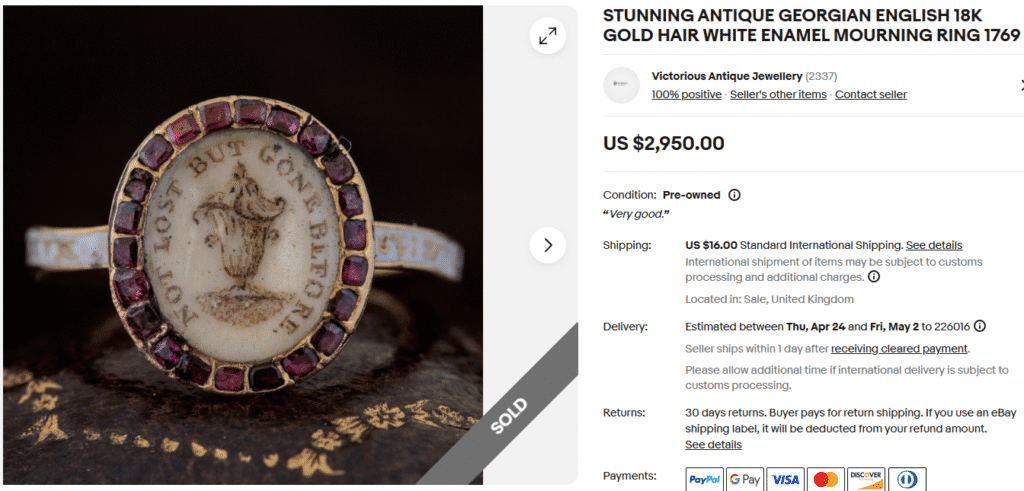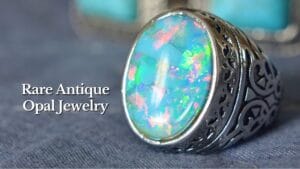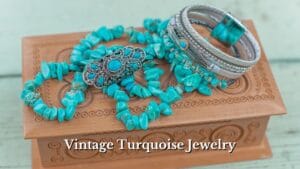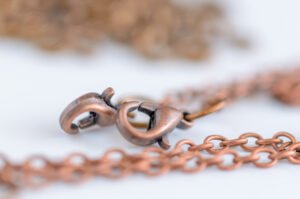If you have some old vintage gold rings in your jewelry box, you just got rich! Why? Because, among all antique jewelry pieces, rings are easily one of the most sought-after ones that collectors are paying hefty amounts for.
Naturally, most antique gold rings can fetch some amount due to the gold content, but some rare examples can actually be worth tens of thousands! In this guide, I will explain key signs to identify valuable vintage gold rings, along with 10 rare finds worth a lot of money!

How to Identify Valuable Antique Gold Rings? (6 Key Factors)
As I said above, all antique gold rings need not be equally valuable; some will always be worth more than others. So, what decides which old rings are worth tens or hundreds of thousands and which are worth only hundreds?
Here are the key factors that greatly influence antique vintage rings’ value:
Condition and Originality:
Vintage gold rings that are in excellent condition without any serious damage are typically more valuable. Damage like deep scratches, missing stones, and faded gold detailing can significantly reduce a ring’s overall value.
Also, old rings with original settings, prongs, and stones are more valuable. While some organic restoration may be acceptable for collectors, poor repairs such as a fake stone, coloring, plating, etc., are a big no. Collectors despise such artificial features on antique jewelry.
Lastly, original boxes and holders, especially in good condition with brand labels or stamps visible, can also significantly increase an antique ring’s worth.
Gold Karatage, Color, and Gemstones:

Naturally, the karatage of gold (percentage of actual gold content) is a vital indicator of a gold ring’s value. Antique gold rings, particularly those from the Georgian and early Victorian eras, made of higher karat gold (18k, 20k, or higher), are worth the highest amounts.
- 18K (75% gold): Most common in high-end European and Georgian/Victorian rings
- 14K (58.3% gold): Found in most American vintage rings
- 9K (37.5% gold): Common in British antique rings
- 22K (91.6% gold): Extremely rare, seen in very early pieces
Also, the weight and size of the ring are crucial factors for its valuation.
But it’s not just the gold karatage; even the gemstones used in the ring influence its worth. Generally, antique rings feature untreated natural gemstones, which are highly desirable today against the modern lab-grown alternatives.
Besides, the larger, high-quality diamonds and colored gemstones, the higher premiums it tends to fetch, especially if they are original to the piece and well-preserved.
Gold Color & Alloy:
The color of gold, which is a result of different alloys mixed with pure gold, also impacts its value. Here are the most common gold varieties found in vintage rings:
- Yellow Gold: The traditional alloy, typically mixing gold with silver and copper.
- Rose Gold: Increased copper content in the alloy, producing a warm, pinkish hue. Victorian Rose gold rings can be highly popular.
- Green Gold: More silver and less copper in the alloy, generating a greenish-yellow tint. Rarely found in specialized vintage rings.
- White Gold: Popular in the early 20th century as a platinum alternative. Created by adding nickel, palladium, or other white metals to gold.
Age & Style:

The older a gold ring, the rarer and more valuable it is. The reason for it is the construction techniques used in the old times which are now rarer.
Also, vintage rings from certain periods (e.g., Georgian) are much rarer due to fewer surviving examples. Here is a breakdown of different styles and their key features.
- Georgian Era Rings (1714-1837): Georgian rings are mostly made of yellow gold with silver or stone settings displaying natural motifs like flowers, leaves, and vines. The diamond featured simple cuts like point cuts, table cuts, old mine cuts, and rose cuts. The rings often had closed backs with foiled gemstones.
- Victorian Era Rings (1837-1901): This era saw the rise of high karat rose gold rings, featuring symbolic motifs related to love and mourning. Intricate filigree work, repoussé, and chasing techniques became popular and several gemstones, like garnets, amethysts, turquoise, sapphires, pearls, and diamonds were used.
- Edwardian Era Rings (1901-1915): White metals became more popular, alongside yellow gold, with mixed metal rings gaining prominence. The gold work ranges from delicate, lace-like settings to refined filigree and milgrain details, featuring bows, garlands, ribbons, and flowers. Machine-cut diamonds were prominently used.
- Art Nouveau Rings (1890-1915): Both gold and silver rings were popular in this era, but with innovative use of enamel, glass, and horn. The designs tend toward featuring nature-inspired, asymmetrical, and flowing designs, with motifs including female forms, insects (especially dragonflies), flowers, and whiplash curves.
- Art Deco Rings (1920-1935): Platinum rose as a popular metal, along with yellow and white gold. The design shifted toward sleekness, featuring geometric, symmetrical shapes with clean lines and angular patterns. Contrasting Calibré-cut gemstones are common, often arranged with innovative techniques like invisible settings and gemstone mosaics.
Craftsmanship:
For instance, techniques like foil-backed gems, filigree, cannetille work, elaborate repoussé (hammered relief), milgrain edging, hand engraving, and die-stamped settings are difficult to find today. Thus, antique rings featuring this artistry can be highly valuable.
Moreover, gemstones, including diamonds, were cut by hand, resulting in unique facet patterns compared to modern, machine-cut stones. Older cuts, like Old Mine Cut or Old European Cut, are no longer produced, making them highly collectible.
Jewelry Markings:
Jewelry hallmarks are a sign of authenticity. They can offer a lot of information about the ring’s origin, metal purity, and sometimes the manufacturer and manufacturing date. That’s why antique rings with original markings are way more collectible than those without any markings.
Learn more about jewelry hallmarks here!
Rarity:
The rarer an old ring, the more valuable it tends to be. But how can you spot a rare ring? Let’s find out:
There are certain examples which are considered rare and collectible:
- Examples that were produced in a limited edition. Generally, most antique gold rings are one-of-a-kind or part of limited production runs.
- Rings that were made specifically for renowned figures
- Old examples that belonged to or were awarded to significant figures are also considered rare and fetch thousands of dollars.
- Examples that feature stones that are difficult to find today.
10 Rare Antique Gold Rings to Find in Your Jewelry Box!
1. Antique 1832 William IV Gold Ring With Inscription

This is a rare ring featuring a highly detailed scrollwork and enameled center with old cut diamonds in a flower shape, denoting it a mourning ring.
But that’s not it! This special early 19th-century ring sold for an exceptional price due to its historical significance. The delicate inscription on the back of the ring reveals the real story of a man called John Hill, who drowned in an 1832 shipwreck in the Atlantic.
The inscription says: “Dedicated to John Hill, who drowned at sea on his passage home from the West Indies, aged 27 – Obt. 1st April 1832.” You will also see purity marks inside the rim.
2. Antique Empire Royal Award Crown Ring

This is a historically significant piece and, hence, worth thousands. This special 14K gold ring was awarded to Captain Vladimir Yuriev (the captain of the Imperial Yacht Standart) by Tsar Nicholas II in the late 19th Century.
The ring primarily displays a raised crown decorated with 1ct old rose-cut snow-white and pink diamonds. The sides of the ring show the Imperial Coat of Arms: the double-headed eagle.
Such rare antique gold rings with significant provenance can be highly valuable, like this ring sold for almost $27,860 on eBay.
3. Georgian Mourning Ring

This is a rare mourning ring from the Georgian Era featuring red stones. Instead of black enamel, which was common for mourning rings, this one features white enamel, commemorating the death of an innocent, “Hannah Robinson Ob. 5 Aug 1769 Æ 19” as enameled on the band.
The central design displays a sepia image of an ornate commemorative urn with the words “Not Lost But Gone Before” surrounding it. But what makes this ring extraordinary is that the central design and text are made of microscopic parts of the hair of the deceased.
4. Gypsy-Set Diamond Gold Ring

This is a rare Gypsy-Set or flush-fit ring featuring old mine-cut antique diamonds in star-shaped molds. Popular in the Late Victorian Era (1880s–1890s), this ring in solid yellow or white gold can be worth $1,000–$6,000+, depending on the condition.
5. Antique 13th Century Gold Garnet Ring

This is an exceptionally rare 22K yellow gold ring from the 13th Century, roughly dating back to 1280. It features an irregular-shaped garnet cabochon inside an octagonal bezel frame, a style that was highly popular in the late 13th Century among nobility.
The uneven surface and unpolished finish of the ring are signs of its authenticity, justifying its high value of almost $18,300 realized on Etsy!
6. Victorian Serpent Ring (1830s–1860s)

Victorian Serpent rings are highly collectible due to their unique shapes and symbolization of eternal love. This one is a rare 14K coiled ring featuring two snake heads, one with a Ruby and the other with a diamond.
Serpent rings with intricate scales, coiled designs, and sets with more precious gemstones, like turquoise and pearls, could be worth thousands today.
7. Antique “Puzzle” or “Gimmel” Gold Ring

Gimmel rings refer to those featuring interlocking bands that separate and rejoin. Antique gold examples, especially those with intricate designs or symbolic engravings, are highly collectible for their novelty.
This one is an 18K gold ring featuring a rare Fede Gimmel design that allows the heart to move and hands to interlock. The purity marks and the unique design make such gold rings worth thousands.
8. Antique Edwardian 18K Gold Sapphire Diamond Hugs & Kisses Ring

This is a romantic Edwardian antique gold engagement ring featuring seven gorgeous gemstones, including 3 large earth-mined sapphires and four small old rose-cut diamonds in the hugs and kisses (OXOXO) setting.
The band of the ring features English hallmarks, including the crown for gold, ’18’, the Birmingham anchor and date letter ‘h’ for 1907, and the maker’s mark ‘H&S’ for Henry Hyde & Sons of Warstone Terrace.
9. Antique Handpainted Mourning Ring

This is an antique yellow gold Cameo mourning ring featuring a hand-painted portrait of a lady in front of a religious structure. The cameo is surrounded by Freshwater pearls set on an oval-shaped frame. The back of the frame shows the original inscription, including the year 1789.
10. Edwardian Filigree Diamond Ring (1901–1915)

This rare early 20th-century Edwardian gold ring features the delicate lacy filigree work in platinum over gold with Mine European-cut diamonds. The antique artistry of this ring makes it rather rare today and, hence, highly valuable.
Note: This article is intended for informational, educational, and entertainment purposes only. Some images are illustrative and may not represent actual brands, products, or related entities. All trademarks, product names, brand logos, packaging, and other intellectual property referenced remain the exclusive property of their respective owners. Any brand mentions or references are provided solely for descriptive and educational context and do not imply any formal or commercial association.






